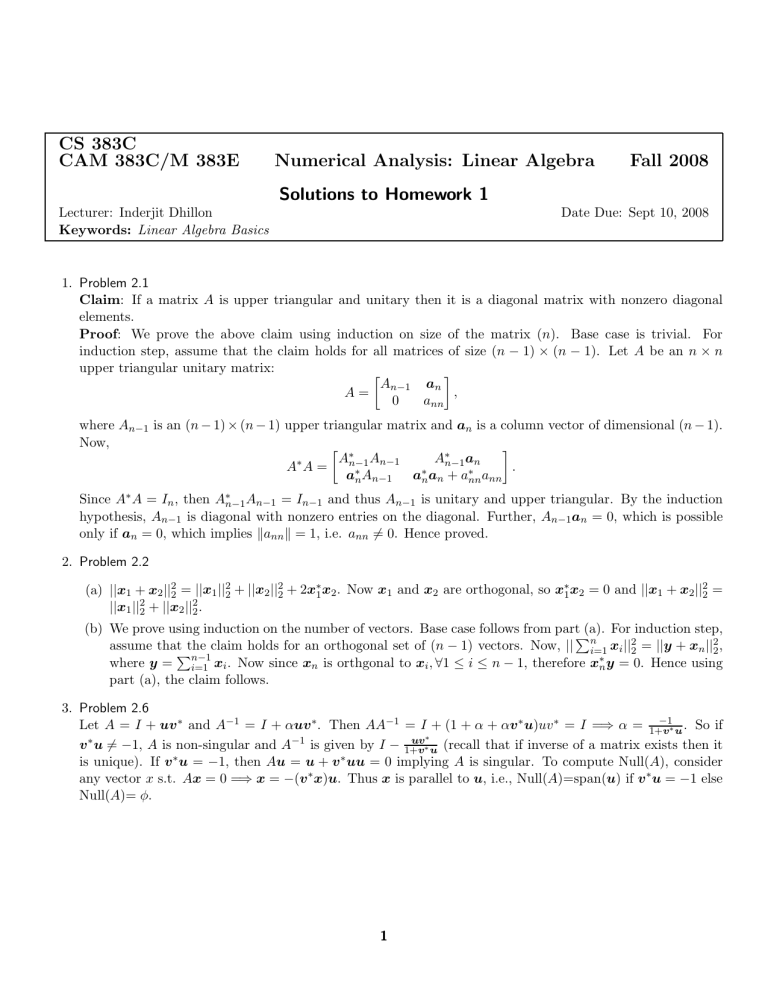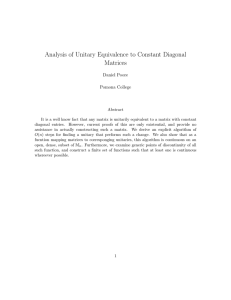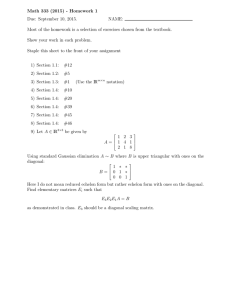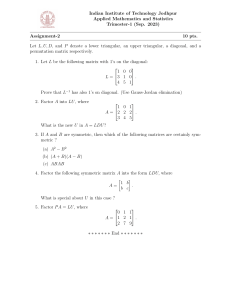
CS 383C CAM 383C/M 383E Numerical Analysis: Linear Algebra Fall 2008 Solutions to Homework 1 Lecturer: Inderjit Dhillon Keywords: Linear Algebra Basics Date Due: Sept 10, 2008 1. Problem 2.1 Claim: If a matrix A is upper triangular and unitary then it is a diagonal matrix with nonzero diagonal elements. Proof: We prove the above claim using induction on size of the matrix (n). Base case is trivial. For induction step, assume that the claim holds for all matrices of size (n − 1) × (n − 1). Let A be an n × n upper triangular unitary matrix: An−1 an , A= 0 ann where An−1 is an (n − 1) × (n − 1) upper triangular matrix and an is a column vector of dimensional (n − 1). Now, ∗ An−1 An−1 A∗n−1 an . A∗ A = a∗n an + a∗nn ann a∗n An−1 Since A∗ A = In , then A∗n−1 An−1 = In−1 and thus An−1 is unitary and upper triangular. By the induction hypothesis, An−1 is diagonal with nonzero entries on the diagonal. Further, An−1 an = 0, which is possible only if an = 0, which implies kann k = 1, i.e. ann 6= 0. Hence proved. 2. Problem 2.2 (a) ||x1 + x2 ||22 = ||x1 ||22 + ||x2 ||22 + 2x∗1 x2 . Now x1 and x2 are orthogonal, so x∗1 x2 = 0 and ||x1 + x2 ||22 = ||x1 ||22 + ||x2 ||22 . (b) We prove using induction on the number of vectors. Base case follows from partP(a). For induction step, assume thatPthe claim holds for an orthogonal set of (n − 1) vectors. Now, || ni=1 xi ||22 = ||y + xn ||22 , n−1 where y = i=1 xi . Now since xn is orthgonal to xi , ∀1 ≤ i ≤ n − 1, therefore x∗n y = 0. Hence using part (a), the claim follows. 3. Problem 2.6 −1 Let A = I + uv ∗ and A−1 = I + αuv ∗ . Then AA−1 = I + (1 + α + αv ∗ u)uv ∗ = I =⇒ α = 1+v ∗ u . So if ∗ uv ∗ −1 v u 6= −1, A is non-singular and A is given by I − 1+v∗ u (recall that if inverse of a matrix exists then it is unique). If v ∗ u = −1, then Au = u + v ∗ uu = 0 implying A is singular. To compute Null(A), consider any vector x s.t. Ax = 0 =⇒ x = −(v ∗ x)u. Thus x is parallel to u, i.e., Null(A)=span(u) if v ∗ u = −1 else Null(A)= φ. 1




